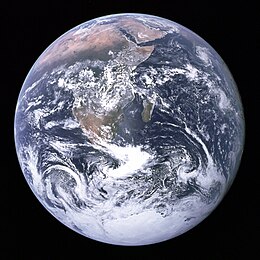Surface of the Earth

The Blue Marble photograph of Earth, taken during the Apollo 17 lunar mission in 1972
|
|||||||||||||||||
| Orbital characteristics | |||||||||||||||||
|---|---|---|---|---|---|---|---|---|---|---|---|---|---|---|---|---|---|
| Epoch J2000 | |||||||||||||||||
| Aphelion |
152,100,000 km (94,500,000 mi)
(1.01673 AU) |
||||||||||||||||
| Perihelion |
147,095,000 km (91,401,000 mi)
(0.9832687 AU) |
||||||||||||||||
|
149,598,023 km (92,955,902 mi)
(1.000001018 AU) |
|||||||||||||||||
| Eccentricity | 0.0167086 | ||||||||||||||||
|
Average orbital speed
|
29.78 km/s (18.50 mi/s)
(107,200 km/h (66,600 mph)) |
||||||||||||||||
| 358.617° | |||||||||||||||||
| Inclination |
|
||||||||||||||||
| −11.26064° to J2000 ecliptic | |||||||||||||||||
| 114.20783° | |||||||||||||||||
| Satellites |
|
||||||||||||||||
| Physical characteristics | |||||||||||||||||
|
Mean radius
|
6,371.0 km (3,958.8 mi) | ||||||||||||||||
|
Equatorial radius
|
6,378.1 km (3,963.2 mi) | ||||||||||||||||
|
Polar radius
|
6,356.8 km (3,949.9 mi) | ||||||||||||||||
| Flattening |
0.0033528 1/298.257222101 (ETRS89) |
||||||||||||||||
| Circumference |
|
||||||||||||||||
|
|||||||||||||||||
| Volume | 1.08321×1012 km3 (2.59876×1011 cu mi) | ||||||||||||||||
| Mass |
5.97237×1024 kg (1.31668×1025 lb) (3.0×10−6 M☉) |
||||||||||||||||
|
Mean density
|
5.514 g/cm3 (0.1992 lb/cu in) | ||||||||||||||||
| 9.807 m/s2 (32.18 ft/s2) (1 g) |
|||||||||||||||||
| 0.3307 | |||||||||||||||||
| 11.186 km/s (6.951 mi/s) | |||||||||||||||||
|
Sidereal rotation period
|
0.99726968 d
(23h 56m 4.100s) |
||||||||||||||||
|
Equatorial rotation velocity
|
1,674.4 km/h (1,040.4 mph) | ||||||||||||||||
| 23.4392811° | |||||||||||||||||
| Albedo | |||||||||||||||||
|
|||||||||||||||||
| Atmosphere | |||||||||||||||||
|
Surface pressure
|
101.325 kPa (at MSL) | ||||||||||||||||
| Composition by volume |
|
||||||||||||||||
Earth (Greek: Γαῖα Gaia; Latin: Terra), otherwise known as the world (especially in geopolitics and geography), is the third planet from the Sun and the only object in the Universe known to harbor life. It is the densest planet in the Solar System and the largest of the four terrestrial planets.
According to radiometric dating and other sources of evidence, Earth formed about 4.54 billion years ago.Earth's gravity interacts with other objects in space, especially the Sun and the Moon, Earth's only natural satellite. During one orbit around the Sun, Earth rotates about its axis over 365 times; thus, an Earth year is about 365.26 days long. Earth's axis of rotation is tilted, producing seasonal variations on the planet's surface. The gravitational interaction between the Earth and Moon causes ocean tides, stabilizes the Earth's orientation on its axis, and gradually slows its rotation.
Earth's lithosphere is divided into several rigid tectonic plates that migrate across the surface over periods of many millions of years. About 71% of Earth's surface is covered with water, mostly by its oceans. The remaining 29% is land consisting of continents and islands that together have many lakes, rivers and other sources of water that contribute to the hydrosphere. The majority of Earth's polar regions are covered in ice, including the Antarctic ice sheet and the sea ice of the Arctic ice pack. Earth's interior remains active with a solid iron inner core, a liquid outer core that generates the Earth's magnetic field, and a convecting mantle that drives plate tectonics.
...
Wikipedia
